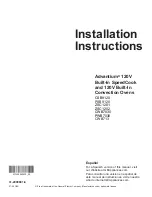
9
Before Operating
Microwave utensil guide
CAUTION
To avoid risk of personal injury or property damage, do
not operate the microwave oven empty.
To avoid risk of personal injury or property damage, do
not use stoneware, aluminum foil, metal utensils, or
metal trimmed utensils in the microwave oven.
To avoid risk of personal injury or property damage, do
not operate the microwave oven empty.
To avoid risk of personal injury or property damage, do
not use stoneware, aluminum fo
ff il, metal utensils, or
metal trimmed utensils in the microwave oven.
Use
Do not use
Oven proof glass (specifically
treated for high intensity heat):
Utility dishes, loaf dishes, pie plates,
cake plates, liquid measuring cups,
casseroles and bowls without
metallic trim.
China:
Bowls, cups, serving plates and
platters without metallic trim.
Plastic:
Plastic wrap (as a cover) - lay the
plastic wrap loosely over the dish
and press it to the sides. Vent
plastic wrap by turning back one
edge slightly to allow excess steam
to escape. The dish should be deep
enough so that the plastic wrap will
not touch the food. Use plastic
dishes, cups, semi-rigid freezer
containers and plastic bags for short
cooking times. Use these with care
because the plastic may soften from
the heat of the food.
Paper:
Paper towels, waxed paper, paper
napkins and paper plates with no
metallic trim or design. Look for the
manufacturer’s label for any special
instructions for use in the
microwave oven.
Metal utensils:
Metal shields the food from microwave energy and produces uneven
cooking. Also, avoid metal skewers, thermometers or foil trays. Metal
utensils can cause arcing, which can damage your microwave oven.
Metal decoration:
Bowls, cups, serving plates and platters without metallic trim.
Aluminum foil:
Avoid large sheets of aluminum foil because they hinder cooking and
may cause harmful arcing. Use small pieces of foil to shield poultry legs
and wings. Keep ALL aluminum foil at least 1 inch from the side walls of
the oven cavity and door of the microwave.
Wood:
Wooden bowls and boards will dry out and may split or crack when you
use them in the microwave oven. Baskets made of wood will react in the
same way.
Tightly covered utensils:
e sure to leave openings for steam to escape from covered cookware.
Pierce plastic pouches of vegetables or other food items before cooking.
Tightly closed pouches may explode.
Brown paper:
Avoid using brown paper bags. They absorb heat and can burn.
Flawed or chi pped cooking utensils:
Any utensil that is cracked, flawed or chipped may break in the oven.
Metal twist ties:
Remove metal twist ties from plastic or paper bags. They become hot and
could cause a fire.
Setting the clock
1. Touch
clock
pad.
2. Enter time using number pads.
3. Touch
clock
pad again.
CLOCK
CLOCK
Learn more about your
microwave oven
Example: setting clock display for 9:00 AM
4. Press 1 for AM and 2 for PM








































